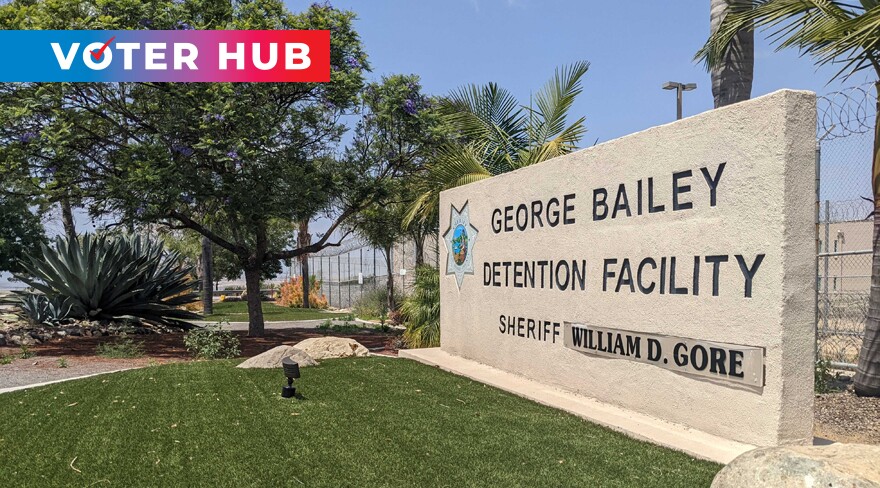Editor's Note: This story was originally published in October, 2022, but it has been updated with the latest information for the District 1 San Diego County Supervisor Primary Election on April 8, 2025.
In some states, the right to vote is taken away forever if you've been convicted of a felony. That’s not the case in California. People who were formerly incarcerated for a felony have their voting rights restored. Those in jail and not serving a felony can also vote.
If you have a friend or relative who is or who has been incarcerated and want to help them vote, here’s some information on how to get started.
Who can — and can’t — vote
U.S. citizens 18 years or older can register to vote and vote in the upcoming April 8 election under the following circumstances:
- If you’re in county jail and not on your way to federal or state prison
- On parole
- On probation
- On mandatory supervision
- On post-release community supervision
- On federal supervised release
- You’re a person with juvenile wardship adjudication
People on parole that had a felony conviction were banned from voting until Proposition 17 passed in 2020.
What’s the difference between jail and prison?
The terms are often used interchangeably but they refer to two different detention facilities.
Jail: Jails are run by county sheriff departments and usually confine people with sentences of a year or less. The people normally in jails are charged with misdemeanors, awaiting trial or sentencing, or confined for civil matters like being in contempt of court. People serving felony sentences can also be confined in jails.
Prison: These are facilities that usually hold people serving felony sentences which can last years or a lifetime. There are both state prisons and federal prisons.
Source: Associated Press Styleguide
Persons who cannot vote or register to vote include those currently serving a state or federal felony prison sentence in the following places:
- State prison
- Federal prison
- County jail or another type of correctional facility
People found "mentally incompetent to vote by a court," cannot cast a ballot.
You can determine if your friend or relative is eligible to vote by filling out this survey on the Secretary of State’s website.
How to vote from jails
The San Diego Registrar of Voters (ROV) said it coordinates with the San Diego County Sheriff's Department and its detention facilities prior to and during each election cycle. This includes coordinating pick-up and drop-off of issued ballots with correctional counselors at each facility.
“We send out to our detention facility contacts: important election dates, updates, flyers, voter registration deadline dates, updated voter registration training materials and we also replenish registration forms if detention facilities need them,” said Cynthia Paes, director of ROV, via email in 2022.
The Sheriff's Department said in an emailed statement in 2025 that it coordinates with the ROV to ensure inmates have access to voter registration year-round.
"The population has access to informational flyers and voting materials provided by the ROV," said Kimberly King, media relations director for the Sheriff's office.
Here are the necessary steps to register to vote and vote while in jail:
1. Determine if they’re already registered to vote. You can check their registration status on the Secretary of State’s website if you’re not sure. If the address that’s on the registration is a residential one, family members, friends or someone within their household can bring the ballot to the incarcerated person, Paes said.
2. If they’re not registered, the incarcerated person will need to request a voter registration card from the facility’s counseling office. The inmate will need to fill out a form as part of making the request.
Make sure they’re able to meet voter registration deadlines.
San Diego County jails
San Diego County has a state prison, Richard J. Donovan Correctional Facility, and several jail facilities:
- East Mesa Reentry Facility
- George Bailey Detention Facility
- Las Colinas Detention and Reentry Facility
- San Diego Central Jail
- South Bay Detention Facility
- Vista Detention Facility
Inmates at these jail facilities can vote unless they’re serving time for a felony. Prisoners at Donovan cannot vote since they’re serving a state prison sentence.
3. Mail-in ballots are sent to the voter via USPS on the address indicated on registration forms whether that be the residence or jail. If the incarcerated person doesn’t have a household member to bring them a ballot sent to a residential address, then they can make a change to their mailing address by asking for a ballot request form through a correctional counselor.
“It’s a one-time-use form and will not make the change permanently to their registration file,” said Cynthia Paes, director of ROV, via email. “If they want to make a permanent mailing address change, they can note it on the ballot request form or fill out a new voter registration form.”
If a ballot was requested but the inmate was released prior to receiving it, they can still vote. They can go to any voting center in the county and request a provisional ballot.
4. Ballots sent to facilities are collected separately and provided to the facility’s counseling staff who then hand them to the voter. Writing utensils are free and provided to incarcerated people, the sheriff’s department said. When completed, ballots are mailed back to the ROV by each voter. If a voter didn’t receive their ballot, they can ask their correctional counselor to coordinate with the ROV to get one.
Nonprofits helping inmates vote
Some nonprofit organizations partner with the jails, ROV and sheriff’s department to help register incarcerated people to vote. The League of Women Voters works with the sheriff’s department to assist with voting. San Diego-based Pillars of the Community also helps inmates vote.
Robert Myers is an inside organizer with Pillars of the Community, currently incarcerated at George Bailey Detention Facility, a county jail. Part of his job includes canvassing people in the jail and seeing if they’re interested in voting.
“What we try to do is basically we write (to) the counselor, and the counselor sends you a voter registration card if you qualify,” Myers said. “I help the guys fill out the voter registration card, and we send it in.”
Other organizers within the jail were recruited like James Pittman. He worked with Pillars registering people to vote for a year. Laila Aziz, director of operations at Pillars, said Pittman died in 2025 after he fell from his top bunk.
"James was instrumental in helping community members in jail register to vote," Aziz said.
Myers started canvassing in July 2022 and helped people fill out forms to their counselors to request voter registration cards.
Myers also plays a part in oversight — making sure those who ask for registration cards and ballots actually receive them. In August (2022), he raised an issue of eight inmates not receiving registration cards to Pillars. Pillars contacted their legal partners and the League of Women Voters. The League reached out to ROV and asked them to provide the facility with more registration cards because counselors allegedly told inmates they didn’t have any.
Laila Aziz, director of operations at Pillars, said it’s imperative that registration cards are sent in a timely manner, and the jail's mailing system can make that challenging.
“If we register people to vote on the last day of registration, they will never get their ballot through that mail system at the county jail in time to vote. So their voter ballot will not be postmarked on the day that it allows them to vote,” she said.
A representative for the Sheriff’s department said they hadn’t heard of issues with providing registration cards to inmates.
“The folks within our facilities receive mail almost daily. So this should not be any different," the representative said. "If anyone feels as though they have not received the (registration) card, please have them check with the deputies and/or the counselors.”
Aziz said that having a voting center within the jails on Election Day where inmates could cast provisional ballots would be a better system than having to request through the counselors.
Pillars and the League supported AB 544, a proposed assembly bill that could improve conditions. It would create a pilot program to improve voter participation in jail facilities. Grants would have been given to county election offices in the County of San Benito, the County of San Mateo, and the County of Santa Cruz.
Gov. Gavin Newsom vetoed the bill in September 2024, however.
"While I appreciate the author's commitment to this issue, under the Elections Code, counties are able to establish these types of programs without statutory authority," Newsom said in his veto message. "Further, this bill creates a new, unfunded grant program and should be considered in the annual budget process."
How to vote after finishing a felony sentence
The right to vote is restored once someone finishes a felony sentence. However, they must re-register even if they’ve been registered before. Here’s how they can do that:
1. If it’s uncertain whether or not they can vote, they can take this survey from the Secretary of State’s office to verify.
2. They can register to vote via the Secretary of State’s website or fill out a registration card. They can get a registration card from the Secretary of State or San Diego’s ROV.
➡ To register online you will need the following:
- Your state driver's license or identification card number
- The last four digits of your social security number
- Your date of birth
Just make sure the application is received or postmarked 15 days prior to Election Day to be able to vote.
3. Or they register to vote at any voting center the day of the election. "Now that we have same-day registration, folks can show up at any vote center up until Election Day to register and vote on the same day," Paes of the ROV said in 2022.
4. They can vote by mail or in-person at a voting center. Every active registered voter will start receiving ballots in the mail the week of March 10. Voters can start dropping off ballots on March 11 at ballot drop off boxes. Starting Saturday, March 29, seven vote centers will be open daily from 8 a.m. to 5 p.m. until the final day of voting on Tuesday, April 8, when 13 vote centers will be open from 7 a.m. to 8 pm.
Important
🗳️ Vote-by-mail ballots begin to be sent to all active California registered voters starting March 10. The last day to register to vote is March 24. (If voters miss this deadline they can still register and vote in person at any vote center location.) April 8 is the election day, but many vote centers are open before that. Vote center and drop-off locations close at 8 p.m. on election day.







